

| Online: | |
| Visits: | |
| Stories: |

| Story Views | |
| Now: | |
| Last Hour: | |
| Last 24 Hours: | |
| Total: | |
My Top Five Favorite Mora Style Knives
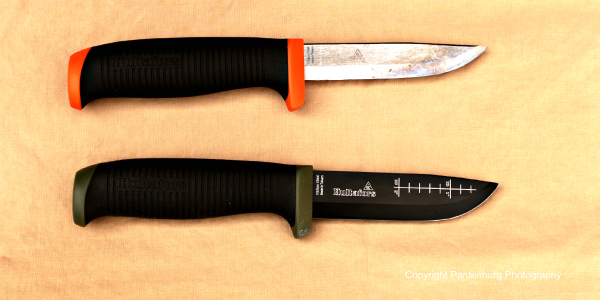
For everyday, all-around use, it is hard to beat a Mora style knife. Here are my favorites.
by Leon Pantenburg
Moro is a style of knife. The name is synonymous with the Scandinavian knife design that has been used virtually unchanged for centuries. There are several companies trading on Mora style knives with Mora in their name.
The Mora style is defined as a knife with a rigid, three-to-four-inch blade, a Scandinavian bevel grind and overall length of about eight inches. The handle typically doesn’t have a guard, and the knife is intended to be an all-purpose, general-use cutting tool. With a Mora style knife, you can get a quality fixed blade, comfortable handle and reasonable price, all in the same package.
This Mora background info comes from Ragnar’s Ragweed Forge: “The town of Mora, Sweden has been a knife-making center for centuries. Smiths in Mora developed a basic, functional style that became known as the ‘Mora Knife.’ Mora knives place function before style,” according to Ragnar. “They have the flat Scandinavian grind that goes cleanly to the edge, and come from the factory very sharp.”
My History with the Mora Style
My original “Mora” cost about $9, and I bought it to try out as a potential steel striker for flint and steel fire making. I could never get the high carbon steel blade to spark and the Mora ended up as a camp utility knife. As such, it peeled potatoes, cleaned fish, sliced summer sausage, whittled kindling, and performed just about every cutting task imaginable.
It went on a lot of canoe trips, because if my Mora got dumped or dropped in the river, there wasn’t a big investment lost.
Today, I have several models of a Mora, and they range in price from almost $300 to $13.95. Regardless of cost, these blades can be relied on, and mine get used a lot.
Here are my top five favorites:
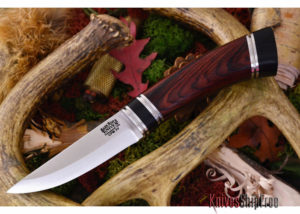
The Bark River Scandi combines traditional styling with modern materials.
Bark River Scandi: Bark River brought out the Scandi a couple years ago, and it combines the old Scandinavian design with state-of-the-art metal technology. Made of CPM 3V steel, the Scandi is available is a variety of handle materials. This can range from basic, bullet-proof micarta (my choice for a knife that will be used hard and depended on) to various exotic woods.
The generous, ergonomic handle and excellent blade geometry make a user knife that also looks good. (Read the review!) Costs of the Scandi vary, depending on handle material. Basic models start at about $260. Use it as hard as you want to – it carries an unconditional warrenty.
Black Horse Knives Feather Stick: BHK set a new standard for the ancient Mora design last year with the Feather Stick. The Feather Stick (Check out the review) uses the time tested Scandinavian design that goes back at least a thousand years to the Vikings.
But the FS is also solid, full tang survival knife. Made with quality steel, and a micarta handle, the knife can handle any survival task along with camp duties of peeling potatoes, whittling wiener sticks, processing tinder, cleaning fish etc. The Feather Stick goes for $150.
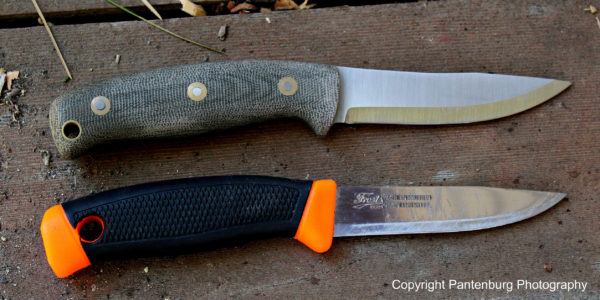
The Feather Stick, top, and the Mora 840 Clipper show the classic, proven Scandinavian design.
Troop 18’s Mora Companion: Over the years, Boy Scouts and volunteers of Troop 18 in Bend, OR, have bought 90 Model Clipper 840 Fixed Blade Outdoor Knife. Several years ago, a scout got severely cut at camp when his folder’s blade lock failed. The troop committee decided to look for a safer knife that beginners could use.
I headed a group of volunteers to find an inexpensive, practical, rigid blade knife that would become the troop’s knife standard.
After a lot of testing, we decided on the Clipper because of the bright color, inherent safety factor, low cost and the soft, easy-to-hold handle. The boys use the Companions for everything from cutting vegetables for stew, to whittling to cleaning fish.
The knives are lightweight and hold an edge very well. In fact, one of our adult volunteers completely gutted and skinned a deer with his Companion, and claimed the blade was still shaving-sharp at the end of the task. He liked it so well, he went on to use it on another deer and on elk, moose and wild pigs. (Click here for the review and video.) You can get a Clipper for $13.97.
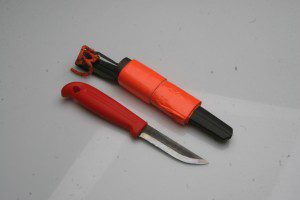
This Marttiini is a good choice for your Ten Essentials. The duct tape wrapped around the sheath is an added tool.
Marttiini Condor Timberjack: Survival expert Peter Kummerfeldt carries a similar model as part of his survival gear, and I bought one shortly after I attending one of his seminars. Peter, a former big game guide, has used his Marttiini on everything from bighorn sheep to elk and deer. Personally, I like a longer, wider blade for such field dressing work, but skill and experience trump equipment every time!
As a small game knife, the Marttiini has few peers. The 3-3/4-inch blade is almost perfect for field dressing rabbits and squirrels and it does very well on larger game animals, too.
I field tested my knife at a snowy, slushy Boy Scout camp several years ago, where the Marttinni was used extensively for splitting firewood, whittling kindling and a myriad of rough jobs. Nobody is harder on a knife than a young, enthusiastic scout! The knife came through with flying colors, and earned its position in my daypack. The Marttiini will set you back about $20. The company has other models of affordable knives.
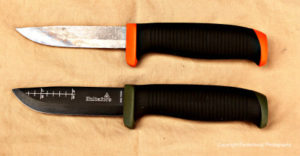
The Hultafors Craftsman knife (top) and Expedition knife are solid, inexpensive blades.
Hultafors Expedition Knife: This blade was designed in Sweden and produced in Taiwan. The Hultafors company got its start in 1883 when they marketed the first folding ruler. Since then, Hultafors has expanded into other tools, and recently added a line of outdoors and bushcraft knives.
The company specializes in making tools for craftsmen, and that’s what these knives feel like. I’m currently testing the Expedition knife and the Craftsman knife, and so far, I like them very much. Universally, a craftsman’s tools will have easy-to-hold, large diameter handles (When was the last time you saw a hatchet, framing hammer or shovel with a slender, short handle?)
The generous handles on these knives are made of PP plastic and fitted with a santoprene friction grip. The plastic sheath holds the knife securely. The sheath comes with an adapter that allows it to be carried on a belt. The Expedition and Craftsman cost, respectively, $30 and $15.
OK – here’s one more bonus knife. I couldn’t leave this one out.
Source: https://survivalcommonsense.com/mora-knives-top-five-favorites/


